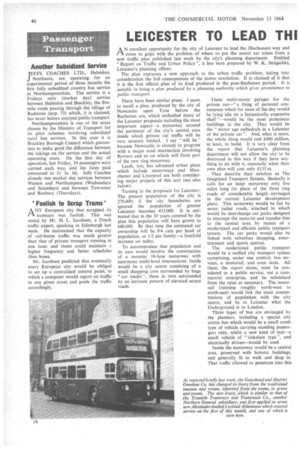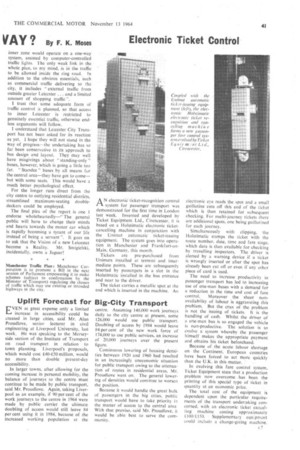LEICESTER TO LEAD TH1
Page 42

Page 43

If you've noticed an error in this article please click here to report it so we can fix it.
VAY ? By F. K. Moses AN excellent opportunity for the city of Leicester to lead the (Buchanan) way and come to grips with the problem of where to put the motor car arises from a new traffic plan published last week by the city's planning department. Entitled "Report on Traffic and Urban Policy ", it has been prepared by W. K. Smigielski, Leicester's planning officer.
The plan expresses a new approach to the urban traffic problem, taking into consideration the full consequences of the motor revolution. It is claimed of it that it is the first official plan of its kind produced in the post-Buchanan period. It is notable in being a plan produced by a planning authority which gives prominence to public transport.
There have been similar plans. I seem to recall a plan, produced by the city of Newcastle upon Tyne before the Buchanan era, which embodied many of the Leicester proposals including the most important aspect—a tnotorway around the perimeter of the city's central area inside which private car traffic will be very severely limited. I say "will be" because Newcastle is already in progress with a major road intersection involving flyovers and so on which will form part of the new ring motorway.
Leeds, too, has advanced urban plans which include• motorways and Manchester and Liverpool are both considering major projects of this sort (see also below).
Turning to the proposals for Leicester: The present population of the city is 270,400; if the city boundaries are ignored the population of greater Leicester becomes 453,000. It is estimated that in the 30 years covered by the plan this population will have grown to 640,000. By that time the estimated car ownership will be 0-4 cars per head of population, or 1-2 per family—a fourfold increase on today.
To accommodate that population and its cars would involve the construction of a monster 16-lane motorway with enormous multi-level intersections. Inside would be a city centre consisting of a small shopping core surrounded by huge " car stacks ", these in turn surrounded by an intricate pattern of elevated access roads. These multi-storey garages for the private car—" a thing of personal convenience which for most of the day would be lying idle on a fantastically expensive shelf "—would be the most prominent buildings in the city. They would be the "motor age cathedrals in a Leicester of the private car". And, what is more, the whole thing would cost £400 million, at least, to build. It is very clear from the report that Leicester's planning department will not allow the city to be destroyed in this way if they have anything to do with it, especially when their own plan will cost only £135 m.
They describe their solution as The Integrated Transport System. Basically it calls for an inner motorway only five miles long (in place of the three ring roads of considerable length, envisaged in the current Leicester development plan). This motorway would be fed by seven radial roads, attached to which would be interchange car parks designed to intercept the motorist and transfer him to the central area by means of a modernized and efficient public transport system. The car parks would also be linked with suburban shopping, entertainment and sports centres.
The modernized public transport would be a unified city transport system comprising, under one control, bus services, a monorail, and even taxis. All these, the report states, must be considered as a public service, not a commercial enterprise, and be subsidized from the rates as necessary. The monorail (running roughly north-west to south-east) would link the main concentrations of population with the city centre, and be to Leicester what the Underground is to London.
Three types of bus are envisaged by the planners, including a special city centre bus which would be a small crush type of vehicle carrying standing passengers only, whilst a new kind of taxi—a small vehicle of "rickshaw type", and electrically driven—would be used.
Inside the motorway would be a central area, preserved with historic buildings, and generally fit to walk and shop in. That traffic allowed to penetrate into this inner zone would operate on a one-way system, assisted by computer-controlled traffic lights. The only weak link in the whole plan, to my mind, is in the traffic to be allowed inside the ring road. In addition to the obvious essentials, Such as commercial traffic delivering to the city, it includes "external traffic from outside greater Leicester ... and a limited amount of shopping traffic ".
I trust that some adequate form of traffic control is planned, so that access to inner Leicester is restricted to genuinely essential traffic, otherwise endless arguments will follow.
I understand that Leicester City Transport has not been asked for its reaction
as yet. I hope they will not stand in the way of progress—the undertaking has so far been conservative in its approach to bus design and layout. They may well have misgivings about " standing-only " buses, however, which is going a little too far. " Standee" buses by all means for the central area—they have got to come— but with some seats. This would have a much better psychological effect.
For the longer runs direct from the city centre to outlying residential districts, streamlined maximum-seating doubledeckers could be employed.
The final plea of the report is one I endorse wholeheartedly—" The general public will have to change their minds and hearts towards the motor car which is rapidly becoming a tyrant of our life instead of being a servant ". It goes on to ask that the Vision of a new Leicester become a Reality. Mr. Smigielski, incidentally, owns a Jaguar!
Manchester Traffic Plan : Manchester Corporation is to promote a Bill in the next session of Parliament empowering it to make schemes (subject to confirmation by the Minister of Transport) regulating the classes of traffic which may use existing or intended highways in the city. AN electronic: ticket-recognition control system for passenger transport was demonstrated for the first time in London last week. Invented and developed by Ticket Equipment Ltd, Cirencester. it is based on a Holstirnatic electronic ticketcancelling machine in conjunction with the Unimat automatic ticket-issuing equipment. The system goes into operation in Manchester and Frankfurt-onMain. Germany, this month.
Tickets are pre-purchased from Unimats installed at termini and intermediate points. These arc subsequently inserted by passengers in a slot in •the Holstimatic installed in the bus entrance and near to the driver.
The ticket carries a metallic spot at the end which is inserted in the machine. An electronic eye reads the spot and a small guillotine cuts off this end of the ticket which is then retained for subsequent checking. For multi-journey tickets there are additional spots, one being guillotined for each journey.
Simultaneously with clipping, the Holstimatic stamps the ticket with the route number, date, time and fare stage, which data is then available for checking by travelling inspectors. The driver is alerted by a warning device if a ticket is wrongly inserted or after the spot has already been cut off or even if any other piece of card is used.
The need to increase productivity in passenger transport has led to increasing use of one-man buses with a demand for a reduction in thc time and cost of fare control. Moreover the sheer nonavailability of labour_is aggravating this problem. But the crux of the problem is not the issuing of tickets. It is the handling of cash. Whilst the driver of a one-man bus is so engaged the vehicle is non-productive. The solution is to evolve a system whereby the passenger himself makes the appropriate payment and obtains his ticket beforehand.
Because of the acute labour shortage on . the Continent. European countries have been forced to act more quickly than the U.K. in this matter.
In evolving this fare control system, Ticket Equipment state that a production problem now overcome has been the printing of this special type of ticket in quantity at an economic price.
The total cost of the equipment is dependent upon the particular requirements of the transport undertaking concerned, with an electronic ticket cancelling machine costing approximately
El OVE 150. Supplementary eq u:pmcnt could include a change-giving machine,
























































































































